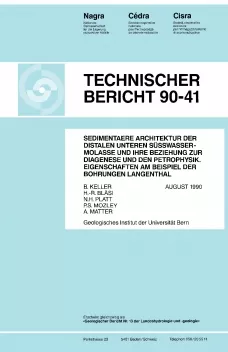
Technischer Bericht NTB 90-41
Sedimentäre Architektur der distalen Unteren Süsswassermolasse und ihre Beziehung zur Diagenese und der Petrophysik. Eigenschaften am Beispiel der Bohrungen Langenthal.
Sedimentological study at outcrop and quarry exposures of distal alluvial deposits in the upper part of the Lower Freshwater Molasse ("Aquitan") has revealed four principal facies. The same facies may also be recognised in boreholes (Langenthal, Weiach, Schafisheim) penetrating the continental succession. These facies make up distinct sediment bodies, or "architectural elements", which may be characterised by their different geometries, and by their petrographic and petrophysical properties: grain size and mineralogical composition; porosity P and permeability k.
Each architectural element may be assigned to a particular depositional setting: Meander Belt RG (MB); Crevasse Splays and Crevasse Channels DFR (CS), Levees and Distal Splays UW (LS), Overbank, Paleosols and Swamps UPS (OPS) and Lacustrine LAK (LAC). The individual architectural elements show strong heterogeneity, resulting both from primary sedimentological differences (particularly in hydrodynamic sorting) and from diagenetic modification (notably through variable cementation).
Meander belt sandstones in the distal Lower Freshwater Molasse reflect the occurrence of two types of mixed load channels. Those with a higher bed load component were dominant in the Lower Freshwater Molasse, producing laterally extensive and longitudinally continuous sandstone bodies 150-1500 m in width. Rarer channels with a higher suspended load component deposited complex amalgamated sandstone bodies 40-100 m in width, commonly in erosive contact with each other.
Architectural modelling permits consideration of the distal Lower Freshwater Molasse in terms of a sandy framework, comprising the channel sandstone bodies, each in contact with their associated crevasse splay and crevasse channel sandstones (median porosity 13.1% (RG) and 8.6% (DFR), median permeability 486md (RG) and 5md (DFR)), and a muddy-silty matrix consisting of interbedded floodplain sediments (practically without measurable porosity and with much lower permeability). The anomalously high total mud content of the sandstone units chiefly reflects the elevated mud content of the incorporated lithic rock fragments.
Comparison with the morphologies of modern alluvial systems suggests that channel sandstone bodies in the Lower Freshwater Molasse are likely to show greater longitudinal continuity, greater width and a higher degree of interconnectedness in an upstream direction (i.e. in proximal areas towards the west and towards the Alpine chain). Conversely, primary depositional porosities and permeabilities of the sandstone units are likely to decrease downstream towards more distal areas in the east and at the northern margin of the basin, although regional differences in tectonic style and diagenesis will also exert a major control on the petrophysical and hydrological properties in any given area.
